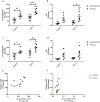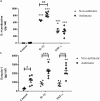Phenotype and Functional Features of Human Telomerase Reverse Transcriptase Immortalized Human Airway Smooth Muscle Cells from Asthmatic and Non-Asthmatic Donors
- PMID: 29339735
- PMCID: PMC5770384
- DOI: 10.1038/s41598-017-18429-0
Phenotype and Functional Features of Human Telomerase Reverse Transcriptase Immortalized Human Airway Smooth Muscle Cells from Asthmatic and Non-Asthmatic Donors
Abstract
Asthma is an obstructive respiratory disease characterised by chronic inflammation with airway hyperresponsiveness. In asthmatic airways, there is an increase in airway smooth muscle (ASM) cell bulk, which differs from non-asthmatic ASM in characteristics. This study aimed to assess the usefulness of hTERT immortalisation of human ASM cells as a research tool. Specifically we compared proliferative capacity, inflammatory mediator release and extracellular matrix (ECM) production in hTERT immortalised and parent primary ASM cells from asthmatic and non-asthmatic donors. Our studies revealed no significant differences in proliferation, IL-6 and eotaxin-1 production, or CTGF synthesis between donor-matched parent and hTERT immortalised ASM cell lines. However, deposition of ECM proteins fibronectin and fibulin-1 was significantly lower in immortalised ASM cells compared to corresponding primary cells. Notably, previously reported differences in proliferation and inflammatory mediator release between asthmatic and non-asthmatic ASM cells were retained, but excessive ECM protein deposition in asthmatic ASM cells was lost in hTERT ASM cells. This study shows that hTERT immortalised ASM cells mirror primary ASM cells in proliferation and inflammatory profile characteristics. Moreover, we demonstrate both strengths and weaknesses of this immortalised cell model as a representation of primary ASM cells for future asthma pathophysiological research.
Conflict of interest statement
The authors declare that they have no competing interests.
Figures









Similar articles
-
Extracellular matrix regulates enhanced eotaxin expression in asthmatic airway smooth muscle cells.Am J Respir Crit Care Med. 2006 Aug 15;174(4):379-85. doi: 10.1164/rccm.200509-1420OC. Epub 2006 May 18. Am J Respir Crit Care Med. 2006. PMID: 16709936
-
Tissue and matrix influences on airway smooth muscle function.Pulm Pharmacol Ther. 2009 Oct;22(5):379-87. doi: 10.1016/j.pupt.2008.12.007. Epub 2008 Dec 24. Pulm Pharmacol Ther. 2009. PMID: 19135163 Review.
-
Extracellular matrix proteins modulate asthmatic airway smooth muscle cell proliferation via an autocrine mechanism.J Allergy Clin Immunol. 2004 Apr;113(4):690-6. doi: 10.1016/j.jaci.2003.12.312. J Allergy Clin Immunol. 2004. PMID: 15100675
-
Role of human airway smooth muscle in altered extracellular matrix production in asthma.Clin Exp Pharmacol Physiol. 2001 Mar;28(3):233-6. doi: 10.1046/j.1440-1681.2001.03426.x. Clin Exp Pharmacol Physiol. 2001. PMID: 11236132 Review.
-
Extra-cellular matrix proteins induce matrix metalloproteinase-1 (MMP-1) activity and increase airway smooth muscle contraction in asthma.PLoS One. 2014 Feb 28;9(2):e90565. doi: 10.1371/journal.pone.0090565. eCollection 2014. PLoS One. 2014. PMID: 24587395 Free PMC article.
Cited by
-
Integrin α7 expression is increased in asthmatic patients and its inhibition reduces Kras protein abundance in airway smooth muscle cells.Sci Rep. 2019 Jul 9;9(1):9892. doi: 10.1038/s41598-019-46260-2. Sci Rep. 2019. PMID: 31289310 Free PMC article.
-
PD 102807 Induces M3 mAChR-Dependent GRK-/Arrestin-Biased Signaling in Airway Smooth Muscle Cells.Am J Respir Cell Mol Biol. 2022 Nov;67(5):550-561. doi: 10.1165/rcmb.2021-0320OC. Am J Respir Cell Mol Biol. 2022. PMID: 35944139 Free PMC article.
-
Molecular Nanomechanical Mapping of Histamine-Induced Smooth Muscle Cell Contraction and Shortening.ACS Nano. 2021 Jul 27;15(7):11585-11596. doi: 10.1021/acsnano.1c01782. Epub 2021 Jul 1. ACS Nano. 2021. PMID: 34197709 Free PMC article.
-
New Tricks for an Old Dog: Biased GPCR Agonism of an M4 Muscarinic Acetylcholine Receptor Antagonist in Airway Smooth Muscle Cells.Am J Respir Cell Mol Biol. 2022 Nov;67(5):515-517. doi: 10.1165/rcmb.2022-0335ED. Am J Respir Cell Mol Biol. 2022. PMID: 36049223 Free PMC article. No abstract available.
-
lncRNA-NEAT1 Sponges miR-128 to Promote Inflammatory Reaction and Phenotypic Transformation of Airway Smooth Muscle Cells.Comput Math Methods Med. 2022 Jan 17;2022:7499911. doi: 10.1155/2022/7499911. eCollection 2022. Comput Math Methods Med. 2022. Retraction in: Comput Math Methods Med. 2023 Jun 28;2023:9782054. doi: 10.1155/2023/9782054. PMID: 35082915 Free PMC article. Retracted.
References
Publication types
MeSH terms
Substances
LinkOut - more resources
Full Text Sources
Other Literature Sources
Miscellaneous

